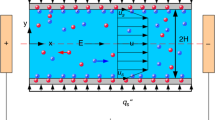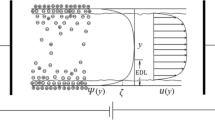Abstract
A numerical solution is derived of the mixed pressure and electroosmotically driven flow in a soft nanochannel considering the steric effect within electric double layer. The electric potential and the velocity distributions are described by the modified Poisson–Boltzmann equation and the modified Navier–Stokes equation under the conditions of boundary slip and constant charge density on the walls. By using the finite difference method, the numerical solutions of the electric potential, velocity and the volumetric flow rate are obtained. Results show that the electric potential increases with the steric parameter. The velocity decreases with the steric parameter for lower surface charge density, while opposite trend can be found for higher surface charge density. We compare the results of soft and rigid nanochannels and find the velocity in the soft nanochannel is larger than that in the rigid one except for the case of higher surface charge density.





Similar content being viewed by others
Abbreviations
- e :
-
The elementary electric charge (C)
- λ FCL * :
-
The dimensionless equivalent EDL thickness inside the PEL
- λ FCL :
-
The equivalent EDL thickness inside the PEL
- H :
-
Height (m)
- K B :
-
The Boltzmann constant (J/K)
- λ :
-
The EDL thickness (m)
- n 0 :
-
The bulk volume concentration of positive or negative ions charge (m−3)
- n :
-
The number densities of the electrolyte ion (m−3)
- v :
-
The steric parameter
- P x :
-
The pressure gradient (k Pa)
- λ * :
-
The dimensionless EDL thickness
- Ω :
-
The dimensionless surface electric density
- E x :
-
The uniformaxial electric field
- N :
-
The number densities of the PEL ion
- T :
-
The temperature of the fluids (K)
- u :
-
The dimensionless velocity field
- u * :
-
The velocity field (m/s)
- u HS :
-
The Helmholtz–Smoluchowski electroosmotic velocity (m/s)
- Z :
-
The valence number of PEL ions
- z :
-
The valence number of ions
- Q :
-
The dimensionless volumetric flow rate
- ε :
-
The fluid permittivity (C/Vm)
- γ :
-
The dimensionless boundary slip parameter
- Γ:
-
The ratio of the maximum velocity of a pressure driven flow to the Helmholtz–Smoluchowki
- γ * :
-
The boundary slip parameter
- µ :
-
The viscosity of the fluids (kg/m s)
- μ c :
-
The drag coefficient of the polyelectrolyte layer
- σ :
-
The surface charge density
- ψ :
-
The dimensionless electrical potential
- ψ * :
-
The electrical potential (V)
- ±:
-
Cations and anions
References
Stone HA, Stroock AD, Ajdari A (2004) Engineering flows in small devices: microfluidics toward a lab-on-a- chip. Ann Rev Fluid Mech 36:381–411
Erickson D, Li D (2004) Integrated microfluidic devices. Anal Chim Acta 507:11–26
Squires TM, Quake SR (2005) Microfluidics: fluid physics at the nanoliter scale. J Rev Mod Phys 77:977–1026
Buren M, Jian YJ, Chang L (2014) Electromagnetohydrodynamic flow through a microparallel channel with corrugated walls. J Phys D Appl Phys 47:425501
Si DQ, Jian YJ (2015) Electromagnetohydrodynamic (EMHD) micropump of Jeffreyfluids through two parallel microchannels walls with corrugated. J Phys D Appl Phys 48:085501
Becker H, Gartner C (2000) Polymer microfabrication methods for microfluidicanalytical applications. Electrophoresis 21:12–26
Ghosal S (2002) Lubrication theory for electro-osmotic flow in a microfluidic channel of slowly varying cross- section and wall charge. J Fluid Mech 459:103–128
Sadr R, Yoda M, Zheng Z, Conlisk AT (2004) An experimental study of electro-osmotic flow in rectangular microchannels. J Fluid Mech 506:357–367
Das S, Chakraborty S (2006) Analytical solutions for velocity, temperature and concentration distribution in electroosmotic microchannel flows in a non-Newtonian bio-fluid. Anal Chim Acta 559:15–24
Xie ZY, Jian YJ (2014) Rotating electroosmotic flow of power-law fluids at high zeta potentials. Colloids Surf A Physicochem Eng Asp 461:231–239
Jian YJ, Su J, Chang L, Liu QS, He GW (2014) Transient electroosmotic flow of general Maxwell fluids through a slit microchannel. Z Angew Math Phys 65:435–447
Buren MDL, Jian YJ, Chang L (2014) Electromagnetohydrodynamic flow through a microparallel channel with corrugated walls. J Phys D Appl Phys 47:425501
Zhao GP, Jian YJ, Chang L, Buren MDL (2015) Magnetohydrodynamic flow of generalized Maxwell fluids in a rectangular micropump under an AC electric field. J Magn Magn Mater 387:111–117
Xing JN, Jian YJ (2016) Electrokineticenergy conversion efficiency inrectangular nanochannels. Appl Math Mech 37:363–372
Ma HC, Keh HJ (2007) Diffusioosmosis of electrolyte solutions in a capillary slit with adsorbed polyelectrolyte layers. J Colloid Interface Sci 313:686–696
Qu WL, Gh MM, Li DQ (2000) Pressure-driven water flows in trapezoidal silicon microchannels. Int J Heat Mass Transf 43:353–364
Pamme N (2006) Magnetism and microfluidics. Lab Chip 6:24–38
Gijs MAM, Lacharme F, Lehmann U (2010) Microfluidic applications of magnetic particles for biological analysis and catalysis. Chem Rev 110:1518–1563
Yang RJ, Fu LM, Lin YC (2001) Electroosmotic flow in microchannels. J Colloid Interface Sci 239:98–105
Xuan XC, Li DQ (2005) Electroosmotic flow in microchannels with arbitrary geometry and arbitrary distribution of wall charge. J Colloid Interface Sci 289:291–303
Jian YJ, Yang LG, Liu QS (2010) Time periodic electroosmotic flow through a microannulus. Phys Fluids 22:04200
Bera S, Bhattacharyya S (2013) On mixed electroosmotic-pressure driven flow and mass transport in microchannels. Int J Eng Sci 62:165–176
Ganguly S, Sarkar S, Hota TK, Mishra M (2015) Thermally developing combined electroosmotic and pressure-driven flow of nanofluids in a microchannel under the effect of magnetic field. Chem Eng Sci 126:10–21
Donath E, Voigt A (1986) Steaming current and streaming potential on structured surfaces. J Colloid Interface Sci 109:122–139
Chanda S, Sinha S, Das S (2014) Steaming potential and electroviscous effects in soft nanochannels: towards designing more efficient nanofluidic electrochemomechanical energy converters. Soft Matter 10:7558–7568
Matin MH, Ohshima H (2015) Combined electroosmotically and pressure driven flow in soft nanofluidics. J Colloid Interface Sci 460:361–369
Poddar A, Maity D, Bandopadhyay A, Chakraborty S (2016) Electrokinetics in polyelectrolyte grafted nanofluidic channels modulated by the ion partitioning effect. Soft Matter 12:5968–5978
Kilic MS, Bazant MZ, Ajdari A (2007) Steric effects in the dynamics of electrolytes at large applied voltages. I. Double-layer charging. Phys Rev E 75:021502
Yazdi AA, Sadeghi A, Saidi MH (2015) Steric effects on electrokinetic flow of non-linear biofluids. Colloids Surf A Physicochem Eng Asp 484:394–401
Garai A, Chakraborty S (2010) Steric effect and slip-modulated energy transfer in narrow fluidic channels with finite aspect ratios. Electrophoresis 31:843–849
Bandopadhyay A, Chakraborty S (2011) Steric-effect induced alterations in streaming potential and energy transfer efficiency of non-Newtonian fluids in narrow confinements. Langmuir 27:12243–12252
Chen G, Das S (2015) Streaming potential and electroviscous effects in soft nanochannels beyond Debye–Hückel linearization. J Colloid Interface Sci 445:357–363
Wu C, Ma G, Zhou P (2008) A review of the study on the boundary slip problems of fluid flow. Adv Mech 38:265–282
Nagayama G, Cheng P (2004) Effects of interface wettability on microscale flow by molecular dynamics simulation. J Heat Mass Transfer 47:501–513
Joly L, Ybert C, Trizac E, Bocquet L (2006) Liquid friction on charged surfaces: from hydrodynamic slippage to electrokinetics. J Chem Phys 125:204716
Chanda S, Das S (2014) Effect of finite ion sizes in an electrostatic potential distribution for a charged soft surface in contact with an electrolyte solution. Phys Rev E 89:012307
Srinivas B (2016) Electroosmotic flow of a power law fluid in an elliptic microchannell. Colloids Surf A Physicochem Eng Aspects 492:144–151
Das S, Chakraborty S (2011) Steric-effect-induced enhancement of electrical-double-layer overlapping phenomena. Phys Rev E 84:012501
Sauer T (2012) Numerical analysis, 2nd edn. Pearson Education Inc, New York
Acknowledgements
The work was supported by the National Natural Science Foundation of China (Grant No. 11472140), the Natural Science Foundation of Inner Mongolia Autonomous Region of China (Grant No. 2016MS0106), and the Inner Mongolia Grassland Talent (Grant No. 12000-12102013).
Author information
Authors and Affiliations
Corresponding author
Ethics declarations
Conflict of interest
The authors declare that they have no conflict of interest.
Appendix
Appendix
1.1 Numerical algorithm
Differential equations Eqs. (3) and (8) are solved by the numerical model, in conjunction with boundary conditions (4) and (9) in the previous section. These equations are solved using the finite different method. The domain y we considered is in the interval [−1, 0] because of the symmetry about the y axis. The y i (1 ≤ i≤n) is regarded as the discrete grid points, the step size is h = 1/n, the electric potential ψ at the point y i is denoted as ψ i = ψ i (y i ). Equation (3) can be discretized as [39]:
where N means the grid point at the interface between soft layer and electrolyte solution. The corresponding boundary conditions (Eq. 4) are discretized as:
In order to improve accuracy of the first order derivative boundary conditions, imaginary electrical potentials ψ 0 and ψ n+1 are introduced in Eqs. (12a) and (12d), which can be expressed by using the values of internal points near the wall. Substituting Eq. (12d) into Eq. (11b) and Eq. (12a) into Eq. (11a), we have
It is noted that the Eqs. (13a) and (13b) are taken as the first (i = 1) and the last (i = n) discrete equations. At the node y N , the electrical potential satisfies the Eqs. (12b, c). Solving these discretized nonlinear differential equation groups by using multivariate Newton’s iteration method. The function F(ψ) is provided by
The Jacobian DF(ψ) of F(ψ) can be written as

where \(A = - 2 - \frac{{h^{2} }}{{\lambda^{2} }}\frac{{\left[ {\cosh (\psi_{i} )(1 - 2v) + 2v(\cosh^{2} (\psi_{i} ) - \sinh^{2} (\psi_{i} ))} \right]}}{{(1 - 2v + 2v\cosh (\psi_{i} ))^{2} }}\). The ith equation of the partial derivative, the ith component of F(ψ), obtained the Jacobian’s ith row with respect to each ψ j , and we utilize the Newton’s Method to solve the problem of the boundary value discretized version since its means to solve F(ψ) = 0. The ψ k+1=ψ k − [DF(ψ k)]−1 F(ψ k) is iterated by Newton’s Method, where k is iteration number. In this paper, we take k = 20. Usually, to best perform the iteration, we solve Δψ = ψ k+1−ψ k in the equation DF(ψ k)Δψ = −F(ψ k). The numerical solution is obtained in the next section.
Rights and permissions
About this article
Cite this article
Xing, J., Jian, Y. Steric effects on electroosmotic flow in soft nanochannels. Meccanica 53, 135–144 (2018). https://doi.org/10.1007/s11012-017-0703-4
Received:
Accepted:
Published:
Issue Date:
DOI: https://doi.org/10.1007/s11012-017-0703-4




